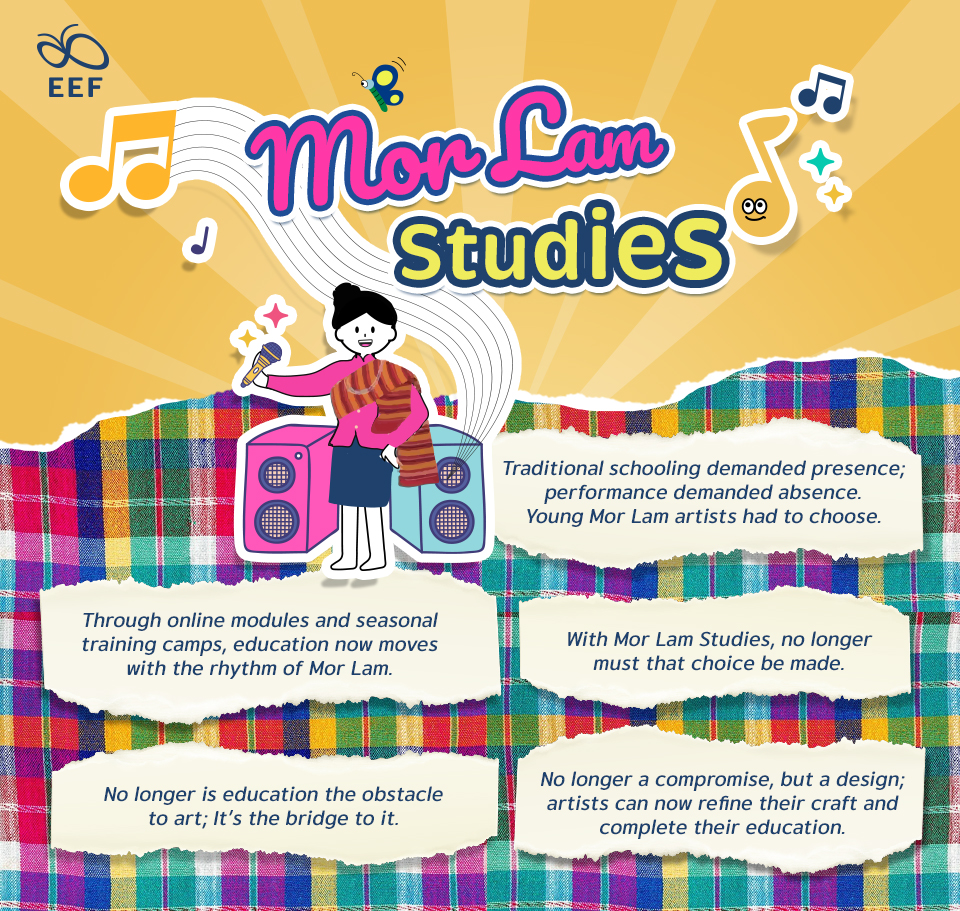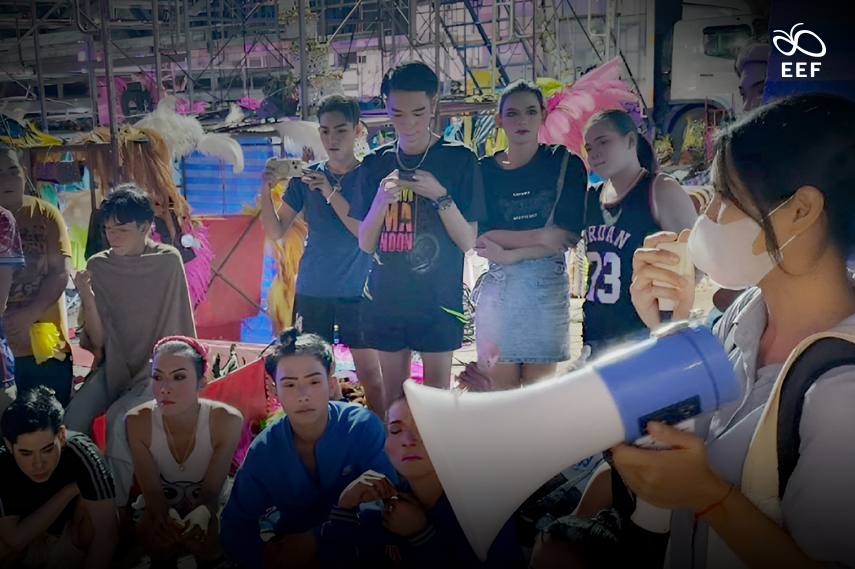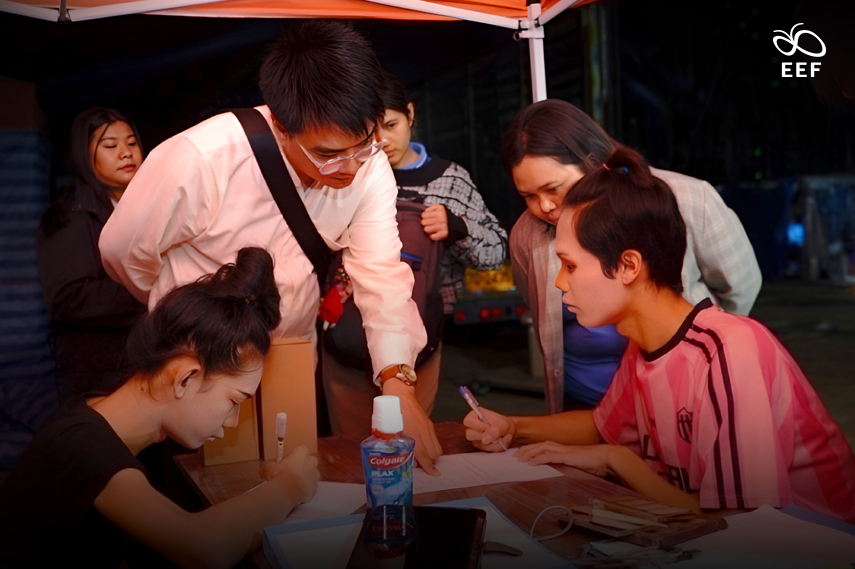
In the heart of Ubon Ratchathani, Thailand, where the pulse of “Mor Lam” echoes through the streets, an extraordinary opportunity emerged, one that would forever change the course of young artists’ lives. More than mere performance, Mor Lam is the soul of Isan, a dynamic fusion of singing, dancing, and storytelling that contributes a significant 6.6 billion Thai Baht to the economy. Yet, beneath its dazzling spectacle lies a stark reality: an ecosystem sustained by performers and artisans, many of whom have never had the chance to complete their compulsory education.
A challenge, however, is not always a barrier; sometimes, it is a call to action. It was this realization that moved Primprapha “Khru Prim” Suwanphrom, Director of the Infinite Intelligence Foundation, embarked on a journey across Northeastern Thailand, visiting Mor Lam troupes right in their element. Among 300-400 individuals contributing, she listened to the untold stories of those who brought the art form to life, and what she saw was a wealth of talent constrained, not by skill but by circumstance—artists who had sacrificed education for their craft, unable to navigate a system that demanded rigid schedules incompatible with a performer’s life.
To these artists, she brought an answer: Mor Lam Studies. An innovation rather than an intervention, the program was designed not to pull them away from their art but to weave learning into it, offering a pathway to a high school diploma without forsaking the stage. For those who had once believed education had passed them by, it was nothing short of a revelation—no longer was the possibility of earning qualifications while remaining true to their passion a distant dream but a tangible reality.

The transformation at hand extends beyond individual artists; it reconfigures the very structure of Mor Lam as a living tradition. For generations, performers have honed their craft through apprenticeship and lived experience, their expertise passed down orally and through hands-on practice. Yet, while their artistry flourished, the absence of formal qualifications left many excluded from broader opportunities in education, employment, and recognition. Addressing these challenges demands more than passion; it requires systemic reform, and reform begins only with a clear understanding of the scale of the issue.

Though deeply rooted in tradition, Mor Lam has long been an evolving art form, sustained by a complex network of professionals far beyond the stage. Musicians, dancers, choreographers, engineers, costume designers, marketers, and stage technicians collectively drive an industry shaped by talent yet constrained by educational barriers. A survey of 250 artists across 29 troupes laid bare a stark reality: over 12.5% had not completed compulsory education or Grade 9, while nearly a third had never finished Grade 12. These figures are not mere statistics; they embody structural challenges faced by those who sustain this cultural legacy. Without formal education, performers often find themselves shut out of alternative career paths, denied financial security, and unable to advocate for their rights. And yet, what is deserved is not always accessible—at least, not until a solution is forged.
To bridge this divide, the Equitable Education Fund (EEF) Thailand, in collaboration with the Infinite Intelligence Foundation, launched the Mor Lam Studies program. Targeting performers aged 16–24, the initiative offers not only academic credentials but also a structured pathway toward sustainable careers. Supported by academic institutions, industry leaders, and Mor Lam pioneers, the program integrates flexible study structures with hands-on creative projects, ensuring that learning is embedded within the artistic process rather than separate from it. No longer must performance and schooling stand in opposition; instead, they become mutually reinforcing.
Within this model lies something greater: a fundamental redefinition of what it means to learn. By bridging cultural heritage and formal education, the Mor Lam Studies program safeguards not only an art form but also the agency of those who sustain it; no longer does education impose conformity; rather, it adapts to the diverse realities of its learners. This philosophy aligns seamlessly with the EEF’s All for Education initiative, a nationwide call for government, industry, and civil society to reintegrate dropouts and at-risk youth into the education system. And in its success, a vital lesson emerges: when education meets individuals on their own terms, it does more than open doors; it transforms lives, strengthens communities, and fuels sustainable cultural and economic growth.

As the Mor Lam Studies program continues to evolve, the EEF will closely monitor its progress, ensuring that its impact reaches far beyond the classroom and the stage. Regular reports will track the success of participants, offering valuable insights that inform the next phase of educational reform, empowering more young artists to thrive both in their craft and their careers.
All For Education is all about people; only when all is in for education is Education For All. Join the movement to reduce educational inequality. Support the EEF by donating to fund research, partnerships, and assistance for children, youth, and adults in need of educational support. Click the link to contribute today and help create a society where education is open and equal for all. Together, we can make a lasting impact.

